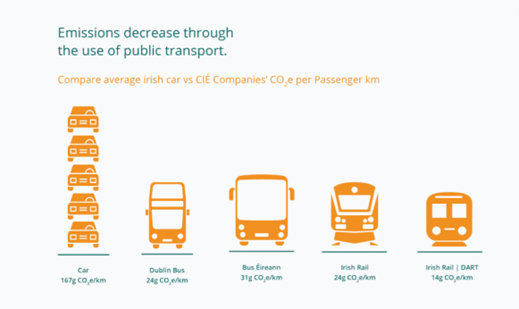Transport
Questions to bear in mind as you read this page -
- What would you like the Council to do to facilitate travel that will reduce our emissions (walking, cycling, car sharing, public transport)?
- What would you like to do to reduce the carbon footprint of how you travel?
What is the challenge
In line with climate action targets, Ireland's transport network is undergoing significant change. These changes include improvements in public transport routes, incentivisation of active travel (walking and cycling) and provision of EV charging infrastructure. This is all aimed at reducing our carbon emissions and reducing the level of fossil fuel-based cars on our roads.
The aim is to deliver at least 500,000 additional daily active travel and public transport journeys by 2030 and a 10% reduction in the number of kilometres driven by diesel and petrol cars. Investments are being made to make it easier for people to choose walking, cycling and use public transport daily instead of having to use a petrol or diesel car.
The National Sustainable Mobility Policy sets out a strategic framework to 2030 for active travel (walking and cycling) and public transport journeys to help Ireland meet its climate obligations. It is accompanied by an action plan to 2025 which contains actions to improve and expand sustainable mobility options across the country by providing safe, green, accessible and efficient alternatives to car journeys.
Where does the Council have influence
- Through Active Travel Planning.
- Incorporation of transport options within the planning process.
- Collaboration with public transport providers.
- Through transitioning and management of its own fleet.
- Through the provision of sustainable modes of transport such as bicycles and e-scooters.
- Management of parking.
- Management of roads.
What is the local picture
Transport accounts for 14% of our emissions in Waterford, 276 ktCO2e.
The private car is the main mode of transportation in Waterford for both school drop offs and work commutes. There is little difference between the city and the county in this respect with 69% of people in the city commuting by car with 66% commuting by car in the county as a whole.

A description of how the different types of transport compare when it comes to greenhouse gas emissions is given below. There are greenhouse gas emissions from cycling and walking.

 Source: Census 2016
Source: Census 2016
Waterford is known for its innovation in the area of active travel as the first county in Ireland to put in place a Greenway. Through NTA funding, the Council Active Travel Team, Climate Action Team and public consultation, cycling and walking routes are being expanded and improved upon.
The Waterford Metropolitan Area Transport Strategy was recently published. This Strategy sets the framework for an accessible, high-quality and integrated transport network that provides for the travel demand and supports the sustainable growth of the Waterford Metropolitan Area. It is important that Waterford City is a city that is a free-flowing city as a major growth engine of the Southern Region. Every hour people spend in traffic is a cost, in terms of that person’s time, in terms of fuel costs and the cost that air pollution is to us all. The Department of Transport estimates that congestion costs the state upwards of €2 billion euros each year.
The Council is currently developing an Electric Vehicle and Related Charging Infrastructure Strategy. This will look to electrify the Council's own fleet and provide additional charging infrastructure for Council and public usage. This process will take place on a phased and gradual basis and is already underway.
What are other places doing
In England, Nottingham City Council are deploying an extensive electric vehicle strategy on a phased basis. To date, they have over 140 electric vehicles in operation. This is compared to just EVs four years ago. The vehicles range from vans to buses to street sweepers. In 2020, in a world first, the Council deployed two fully electric bin lorries. This alone is saving the council an estimated 70 litres of diesel and 360kg of CO2e per day. To further supplement the switch to electric for the public, there are now over 400 charge points throughout Nottingham, with over 150 of these situated in and around the city centre.
For more information, please see here.
In Paris, citizens now have more options than before to travel by bike, by foot or on public transport. Reducing emissions and air pollution in the French capital.
For more information, please see here